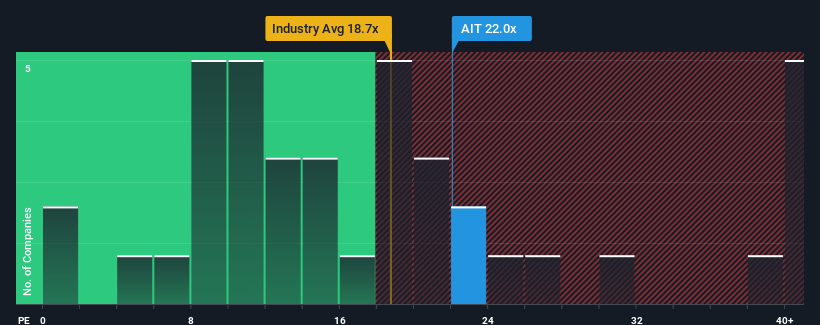
When close to half the companies in the United States have price-to-earnings ratios (or "P/E's") below 16x, you may consider Applied Industrial Technologies, Inc. (NYSE:AIT) as a stock to potentially avoid with its 22x P/E ratio. However, the P/E might be high for a reason and it requires further investigation to determine if it's justified.
Applied Industrial Technologies' earnings growth of late has been pretty similar to most other companies. It might be that many expect the mediocre earnings performance to strengthen positively, which has kept the P/E from falling. You'd really hope so, otherwise you're paying a pretty hefty price for no particular reason.
View our latest analysis for Applied Industrial Technologies

How Is Applied Industrial Technologies' Growth Trending?
The only time you'd be truly comfortable seeing a P/E as high as Applied Industrial Technologies' is when the company's growth is on track to outshine the market.
Taking a look back first, we see that the company managed to grow earnings per share by a handy 3.5% last year. This was backed up an excellent period prior to see EPS up by 72% in total over the last three years. Accordingly, shareholders would have probably welcomed those medium-term rates of earnings growth.
Looking ahead now, EPS is anticipated to climb by 6.2% per annum during the coming three years according to the eight analysts following the company. With the market predicted to deliver 10% growth per annum, the company is positioned for a weaker earnings result.
With this information, we find it concerning that Applied Industrial Technologies is trading at a P/E higher than the market. It seems most investors are hoping for a turnaround in the company's business prospects, but the analyst cohort is not so confident this will happen. There's a good chance these shareholders are setting themselves up for future disappointment if the P/E falls to levels more in line with the growth outlook.
The Bottom Line On Applied Industrial Technologies' P/E
Using the price-to-earnings ratio alone to determine if you should sell your stock isn't sensible, however it can be a practical guide to the company's future prospects.
Our examination of Applied Industrial Technologies' analyst forecasts revealed that its inferior earnings outlook isn't impacting its high P/E anywhere near as much as we would have predicted. Right now we are increasingly uncomfortable with the high P/E as the predicted future earnings aren't likely to support such positive sentiment for long. This places shareholders' investments at significant risk and potential investors in danger of paying an excessive premium.
It is also worth noting that we have found 1 warning sign for Applied Industrial Technologies that you need to take into consideration.
Of course, you might also be able to find a better stock than Applied Industrial Technologies. So you may wish to see this free collection of other companies that have reasonable P/E ratios and have grown earnings strongly.
Have feedback on this article? Concerned about the content? Get in touch with us directly. Alternatively, email editorial-team (at) simplywallst.com.
This article by Simply Wall St is general in nature. We provide commentary based on historical data and analyst forecasts only using an unbiased methodology and our articles are not intended to be financial advice. It does not constitute a recommendation to buy or sell any stock, and does not take account of your objectives, or your financial situation. We aim to bring you long-term focused analysis driven by fundamental data. Note that our analysis may not factor in the latest price-sensitive company announcements or qualitative material. Simply Wall St has no position in any stocks mentioned.